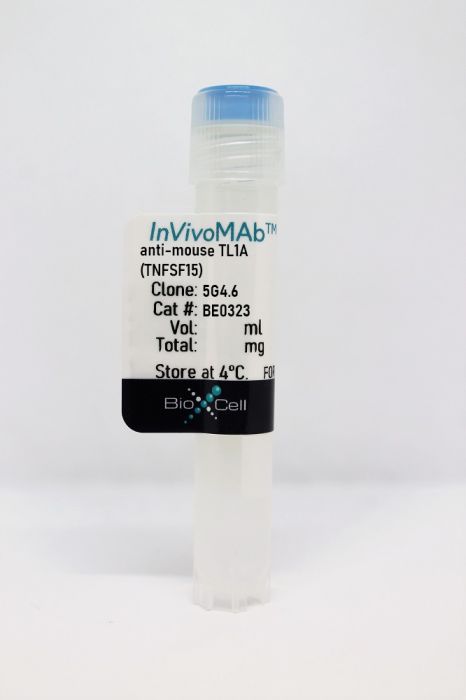InVivoMAb anti-mouse TL1A (TNFSF15)
Product Details
The 5G4.6 monoclonal antibody reacts with the TNF family member TL1A, also known as TNFSF15. TL1A is expressed on activated T cells, dendritic cells, monocytes and endothelial cells. TL1A expression has been shown to be induced by pro-inflammatory stimuli such as TNFα and IL-1α. In contrast to the TNFα receptors, which are expressed on essentially all cells, the receptor for TL1A, DR3 (TNFRSF25), is primarily expressed on T cells, NK cells, and NKT cells, thereby limiting the effects of TL1A. TL1A-DR3 interactions are thought to promote effector T cell proliferation at the site of inflammation and in draining lymph nodes. Blockade of TL1A-DR3 interactions strikingly reduces pathology in several animal models in which autoreactive T cells play a role. TL1A has been linked to inflammatory bowel disease. The 5G4.2 antibody has been shown to block TL1A binding to DR3 and reduce disease severity in mouse models of colitis.Specifications
| Isotype | Armenian hamster IgG |
|---|---|
| Recommended Isotype Control(s) | InVivoMAb polyclonal Armenian hamster IgG |
| Recommended Dilution Buffer | InVivoPure pH 7.0 Dilution Buffer |
| Conjugation | This product is unconjugated. Conjugation is available via our Antibody Conjugation Services. |
| Immunogen | Recombinant murine TL1A |
| Reported Applications |
in vivo TL1A neutralization Flow cytometry |
| Formulation |
PBS, pH 7.0 Contains no stabilizers or preservatives |
| Endotoxin |
<2EU/mg (<0.002EU/μg) Determined by LAL gel clotting assay |
| Purity |
>95% Determined by SDS-PAGE |
| Sterility | 0.2 µm filtration |
| Production | Purified from cell culture supernatant in an animal-free facility |
| Purification | Protein A |
| RRID | AB_2819050 |
| Molecular Weight | 150 kDa |
| Storage | The antibody solution should be stored at the stock concentration at 4°C. Do not freeze. |
Recommended Products
in vivo TL1A neutralization
Richard, A. C., et al. (2015). "The TNF-family ligand TL1A and its receptor DR3 promote T cell-mediated allergic immunopathology by enhancing differentiation and pathogenicity of IL-9-producing T cells" J Immunol 194(8): 3567-3582. PubMed
The TNF family cytokine TL1A (Tnfsf15) costimulates T cells and type 2 innate lymphocytes (ILC2) through its receptor DR3 (Tnfrsf25). DR3-deficient mice have reduced T cell accumulation at the site of inflammation and reduced ILC2-dependent immune responses in a number of models of autoimmune and allergic diseases. In allergic lung disease models, immunopathology and local Th2 and ILC2 accumulation is reduced in DR3-deficient mice despite normal systemic priming of Th2 responses and generation of T cells secreting IL-13 and IL-4, prompting the question of whether TL1A promotes the development of other T cell subsets that secrete cytokines to drive allergic disease. In this study, we find that TL1A potently promotes generation of murine T cells producing IL-9 (Th9) by signaling through DR3 in a cell-intrinsic manner. TL1A enhances Th9 differentiation through an IL-2 and STAT5-dependent mechanism, unlike the TNF-family member OX40, which promotes Th9 through IL-4 and STAT6. Th9 differentiated in the presence of TL1A are more pathogenic, and endogenous TL1A signaling through DR3 on T cells is required for maximal pathology and IL-9 production in allergic lung inflammation. Taken together, these data identify TL1A-DR3 interactions as a novel pathway that promotes Th9 differentiation and pathogenicity. TL1A may be a potential therapeutic target in diseases dependent on IL-9.
in vivo TL1A neutralization, Flow Cytometry
Meylan, F., et al. (2011). "The TNF-family cytokine TL1A drives IL-13-dependent small intestinal inflammation" Mucosal Immunol 4(2): 172-185. PubMed
The tumor necrosis factor (TNF)-family cytokine TL1A (TNFSF15) costimulates T cells through its receptor DR3 (TNFRSF25) and is required for autoimmune pathology driven by diverse T-cell subsets. TL1A has been linked to human inflammatory bowel disease (IBD), but its pathogenic role is not known. We generated transgenic mice that constitutively express TL1A in T cells or dendritic cells. These mice spontaneously develop IL-13-dependent inflammatory small bowel pathology that strikingly resembles the intestinal response to nematode infections. These changes were dependent on the presence of a polyclonal T-cell receptor (TCR) repertoire, suggesting that they are driven by components in the intestinal flora. Forkhead box P3 (FoxP3)-positive regulatory T cells (Tregs) were present in increased numbers despite the fact that TL1A suppresses the generation of inducible Tregs. Finally, blocking TL1A-DR3 interactions abrogates 2,4,6 trinitrobenzenesulfonic acid (TNBS) colitis, indicating that these interactions influence other causes of intestinal inflammation as well. These results establish a novel link between TL1A and interleukin 13 (IL-13) responses that results in small intestinal inflammation, and also establish that TL1A-DR3 interactions are necessary and sufficient for T cell-dependent IBD.



